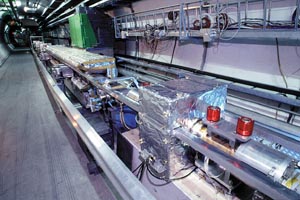Higgs boson escapes detection by scientists who will continue the chase with new collider
A long-sought subatomic particle called the Higgs boson has escaped one of the most intense statistical dragnets in the history of science.The University’s Mark Oreglia, Associate Professor in Physics, and other scientists at CERN, the European particle physics laboratory, had to give up the chase last November, in spite of accumulating evidence for the Higgs which was highly suggestive––but still inconclusive.
 The image above shows the LEP spectrometer, a special dipole magnet designed to measure the energy of LEP’s particle beams. The spectrometer’s main magnet, which is covered with foil to control temperature, obtains precision measurements of the beam energy of CERN’s electron-positron collider ring. |
Without the Higgs boson, physicists believe there would be no mass in the universe––no atoms, no elements, no stars and no humans. And without the Large Electron-Positron Accelerator, which was shut down in November last year, the mysterious particle will remain at large for at least a few more years.
Nevertheless, the LEP Accelerator has made great strides in identifying the possible mass of the Higgs particle and thus its hiding place, Oreglia said. The heavier it is the more power an accelerator must have to produce it. That threshold seems to sit just barely beyond LEP’s capability.
LEP experiments suggest that the Higgs boson has a mass of approximately 115 giga electron volts, which is more than 100 times the mass of a proton.
“We’ll almost certainly see it as we move on to the next steps, namely the Large Hadron Collider or the Tevatron,” Oreglia said. The Tevatron at Fermi National Accelerator Laboratory is the world’s most powerful accelerator. It will begin its second round of experiments in March, following a period of technological upgrades.
The Large Hadron Collider at CERN will be seven times more powerful than the Tevatron. If the Higgs boson is still on the loose in 2006, when the LHC is scheduled to begin operation, Oreglia will be looking for it.
“Mark Oreglia in recent years has been driving the Chicago effort in Higgs searches,” said Frank Merritt, Professor and Chairman of Physics. “In fact, he devised a new search to look for what may be a rare decay mode of the Higgs. He organized and led that search at LEP and has gotten results.”
Oreglia’s team has focused its efforts on searching for the Higgs boson in places where few others bother to look. “We’re looking for the Higgs in various guises, making sure we cover the territory completely,” he said.
The LEP originally had been scheduled to shut down at the end of September so preparations for the construction of the Large Hadron Collider could begin. But when tantalizing evidence for the Higgs boson began to appear, CERN put the LHC construction on hold and extended LEP’s 11-year operation for another month.
Further extensions would have incurred millions of dollars in construction delays.
Three CERN advisory panels were divided about granting LEP another extension. On Nov. 11, the lab’s director-general announced that construction of the LHC would proceed.
As a member of the Higgs working group at CERN, Oreglia contributed to the intense data analysis that led to CERN’s extension decision. The working group consisted of approximately a dozen scientists who pooled data the LEP had churned out for 2,000 collaborators in four major experiments. Oreglia is associated with the Omni-Purpose Apparatus at LEP experiment, which is more commonly referred to as OPAL.
“It’s difficult to take experimental data from different apparatuses and put them together and really understand the uncertainties,” Oreglia said. “It was a tremendous episode in science, the way this working group combined independent results and checked them in record time.”
Two of the experiments produced “absolutely golden candidates for the Higgs boson,” Oreglia said. The other two experiments, meanwhile, yielded less significant events that added to the weight of the entire result.
“We’re on the statistical margins,” Oreglia said. “There are things that don’t quite look right, but we’re dealing with very small numbers. You have to be careful with statistics of small numbers.”
Despite his doubts, Oreglia leaned toward extending LEP’s operation. After enduring many sleepless nights, he said, CERN physicists now must await the start-up of their new accelerator in 2006 to learn the true meaning of their latest results.
![[Chronicle]](/images/small-header.gif)